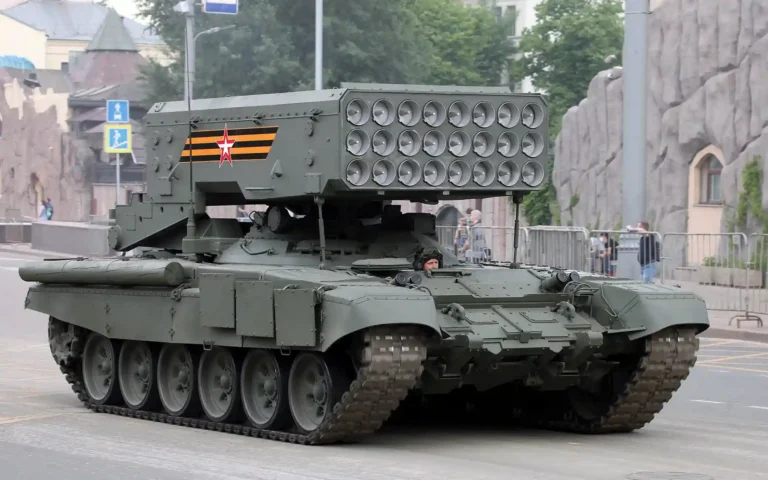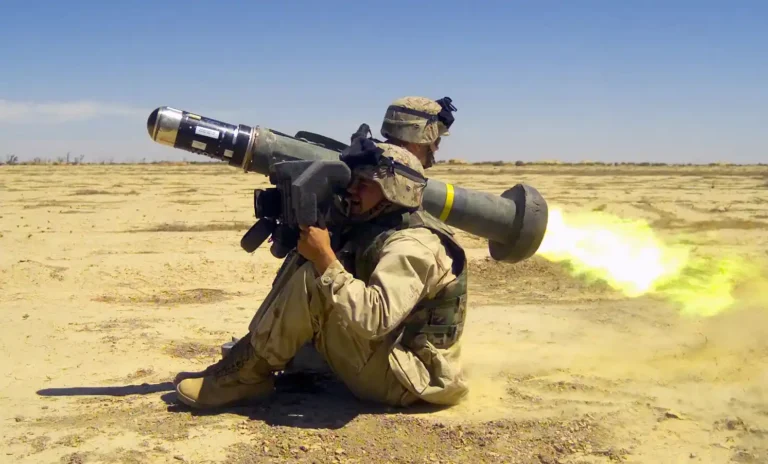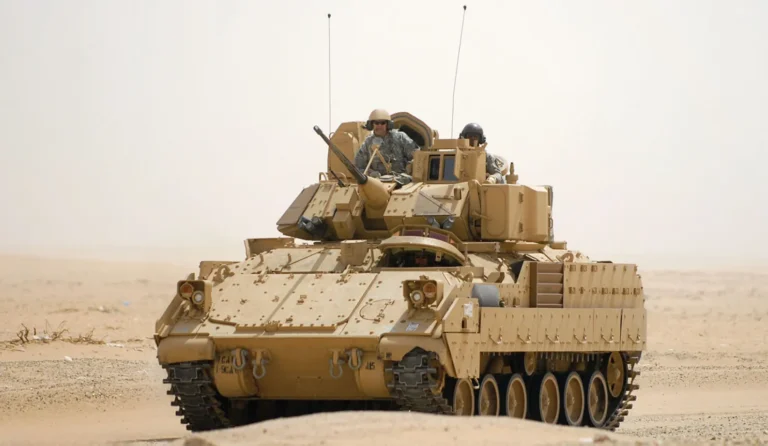Follow Us:
Share
Table of Contents:
The M1 Abrams tank is arguably one of the most recognized and respected battle tanks in the world. Known for its formidable firepower, advanced armor, and outstanding mobility, it has been a cornerstone of the U.S. military’s armored forces since its introduction.
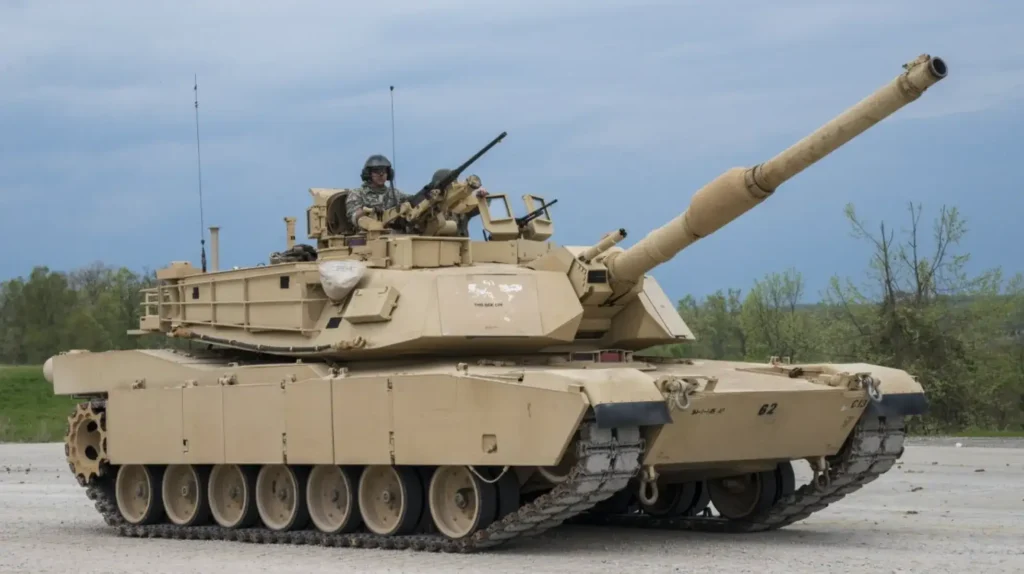
If you’re curious about the M1 Abrams tank — from its armor to its top speed and even inside features — this guide will cover it all.
History and Development of the M1 Abrams Tank
The Origins of the M1 Abrams
The M1 Abrams was developed in the late 1970s to replace the aging M60 Patton series. During the Cold War era, the U.S. military saw the need for a new main battle tank that could match the latest Soviet designs. This led to the birth of the M1 Abrams, named after General Creighton Abrams, a former Army Chief of Staff and commander in the Vietnam War.
The development process was driven by a need for a modern tank that prioritized protection, firepower, and mobility. The M1 Abrams was officially introduced in 1980 and has since become the primary battle tank of the United States.
Key Variants and Upgrades Over Time
Since its inception, the M1 Abrams tank has gone through several upgrades to adapt to evolving battlefield requirements. Here are the key variants:
- M1 (1980): The original version, equipped with a 105mm gun and standard armor.
- M1A1 (1985): Introduced a larger 120mm gun and improved armor, including reinforced protection against chemical attacks.
- M1A2 (1992): Featured advancements in digital technology, including upgraded electronics and command systems.
- M1A2 SEP (System Enhancement Package, 1999): Brought additional technological upgrades, like improved thermal sights and targeting systems.
- M1A2C and M1A2D (2020s): The latest versions focus on advanced digital features, improved armor configurations, and counter-improvised explosive device capabilities.
These upgrades have kept the M1 Abrams relevant and effective, cementing its reputation as one of the most versatile battle tanks in history. The new M1 Abrams tank variants continue to evolve with better armor, advanced systems, and powerful engines.
M1 Abrams Specifications and Features
M1 Abrams Spall Liner and Protection Features
One of the most critical features of the M1 Abrams tank is its advanced armor. The M1 Abrams uses a composite armor known as Chobham armor, which combines layers of ceramics, metal, and other materials to provide exceptional protection. This armor has evolved over the years to enhance protection against kinetic and chemical threats.
In addition to the outer composite armor, the M1 Abrams is equipped with a spall liner. This liner is designed to protect the crew by absorbing and deflecting fragments from penetrating rounds, reducing the likelihood of injuries from internal shrapnel. The combination of the external composite armor and internal spall liner makes the M1 Abrams one of the most secure tanks for its crew in the world.
M1 Abrams Tank Engine and Powertrain
The M1 Abrams is powered by the AGT1500 gas turbine engine, which provides a unique advantage in the battlefield. This engine is essentially a jet engine adapted for land use. It delivers up to 1,500 horsepower, giving the tank an impressive combination of speed and mobility. The M1 Abrams engine can use a variety of fuels, including diesel, kerosene, and even jet fuel, making it versatile in different conditions.
Specifications of the M1 Abrams Engine:
| Feature | Specification |
| Engine Type | AGT1500 Gas Turbine |
| Horsepower | 1,500 HP |
| Fuel Capacity | 500 gallons |
| Top Speed | 45 mph on road, 30 mph off-road |
| Range | Approximately 265 miles (430 km) |
The engine’s power and versatility enable the tank to tackle various terrains, from deserts to urban environments. However, this power comes at a cost. The fuel consumption of the M1 Abrams MPG (miles per gallon) is high, with a rating of around 0.6, which means frequent refueling is necessary in extended combat situations.
M1 Abrams Weight and Dimensions
The M1 Abrams Tank weight is one of the factors that significantly impact its mobility and operational tactics. Here are some critical of M1 Abrams tank dimensions:
| Parameter | Measurement |
| M1 Abrams Weight | Approx. 60 tons (up to 73.6 tons in newer models) |
| Length (with gun) | 32.04 feet |
| Width | 12 feet |
| Height | 8 feet |
Despite its considerable weight, the M1 Abrams tank remains highly mobile, thanks to its powerful engine and advanced suspension system. This balance of weight and mobility enables it to maneuver in tight spaces while maintaining defensive strength.
M1 Abrams Armament and Firepower
The M1 Abrams tank is known for its powerful 120mm smoothbore gun. This gun, made by Rheinmetall, provides a significant advantage in terms of firepower. Capable of firing a variety of munitions, the M1 Abrams can engage targets at long distances with remarkable accuracy.
Key Specifications of the M1 Abrams Gun:
| Specification | Details |
| Main Armament | 120mm M256 Smoothbore Cannon |
| Secondary Armament | M2 .50 caliber machine gun, M240 7.62mm machine guns |
| Firing Range | Up to 4,000 meters |
| Ammunition Types | Armor-Piercing Fin-Stabilized Discarding Sabot (APFSDS), High-Explosive Anti-Tank (HEAT) |
The M1 Abrams firing capabilities make it one of the deadliest tanks on the modern battlefield. The combination of advanced targeting systems, high-velocity rounds, and a skilled crew ensures maximum effectiveness.
M1 Abrams Blueprint: Understanding the Design and Layout
M1 Abrams Blueprint
The blueprint of the M1 Abrams provides a detailed visual representation of its complex design and layout. A blueprint is crucial for understanding the technical and structural aspects of the tank, offering insights into its dimensions, armor placement, and internal configuration.
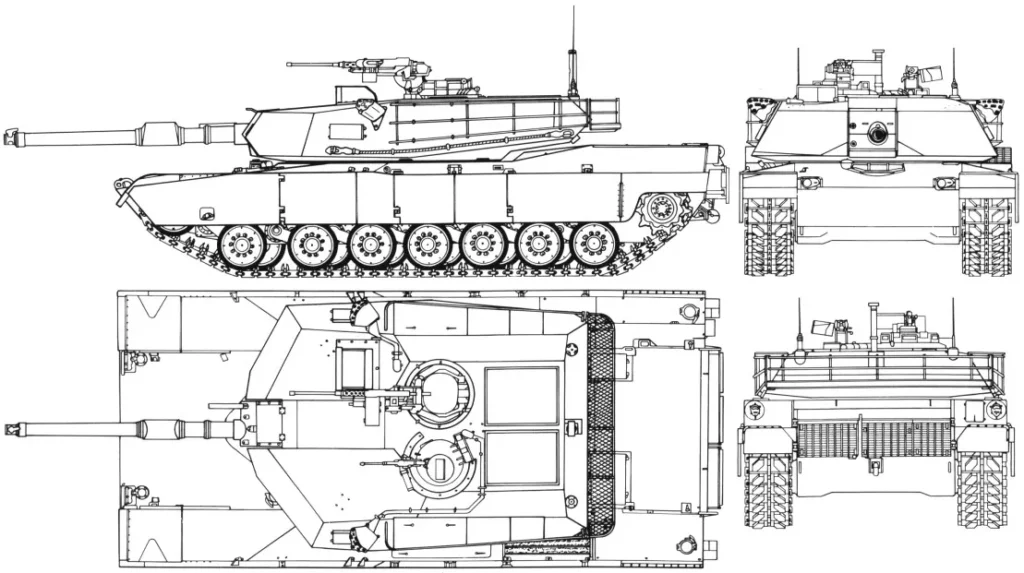
These blueprints serve not only as a guide for manufacturing but also for maintenance and repair, enabling military engineers to work with precise specifications.
M1 Abrams Turret
The M1 Abrams turret is an engineering marvel that combines heavy armor, advanced optics, and powerful weaponry. It is designed to be a flexible and reliable weapon platform capable of adapting to a wide range of combat situations.
A Ukrainian M1A1 Abrams with the K-1 and ARAT ERA pic.twitter.com/VYI8KiN4rP
— 𝔗𝔥𝔢 𝕯𝔢𝔞𝔡 𝕯𝔦𝔰𝔱𝔯𝔦𝔠𝔱△ 🇬🇪🇺🇦🇺🇲🇬🇷 (@TheDeadDistrict) October 22, 2024
With its 360-degree rotation, advanced fire control systems, and layered armor protection, the turret plays a central role in the tank’s dominance on the battlefield.
M1 Abrams Interior Layout
Inside M1 Abrams tank, the layout is designed for efficiency, safety, and optimal performance. The tank houses a four-person crew: the commander, gunner, loader, and driver. Each crew member has a designated compartment with specific controls and equipment tailored to their role.
The M1 Abrams interior is equipped with advanced digital displays and control panels, providing the crew with real-time information on the tank’s performance and the battlefield situation. The use of modern technologies, such as thermal imaging and night vision, enhances the tank’s operational capabilities in diverse conditions.
Inside M1 Abrams Driver Seat and Controls
The driver’s seat is located in the front of the tank, with a specialized control system. The M1 Abrams driver operates the tank using a set of joysticks and pedals, similar to a video game controller, which allows for precise movements.
The driver’s compartment is compact but equipped with a comprehensive display that provides critical data on speed, fuel levels, and engine status.
M1 Abrams Crew: Roles and Responsibilities
The M1 Abrams crew consists of four members, each with specific duties:
- Commander: Oversees the entire operation and gives orders to the crew. The commander is responsible for situational awareness and tactical decisions.
- Gunner: Operates the main cannon and secondary machine guns. The gunner works closely with the commander to identify and engage targets.
- Loader: Handles ammunition and ensures the main cannon is ready to fire. The loader’s role is crucial for maintaining the tank’s rate of fire in combat.
- Driver: Manages the movement and positioning of the tank. The driver’s skill is vital for maneuvering the tank safely and effectively in various terrains.
Advanced Technology Inside the M1 Abrams
The M1 Abrams tank features some of the most advanced technology available in armored vehicles. These include:
- Thermal Imaging Systems: Allow the crew to identify targets even in low visibility conditions, such as night or dense smoke.
- Fire Control System: Uses advanced targeting computers to improve accuracy and reduce response times.
- Communications Equipment: Ensures clear and secure communication between the crew and other military units.
All of these elements combine to create a highly efficient and deadly machine that can operate effectively in diverse combat scenarios.
Performance and Capabilities of the M1 Abrams
M1 Abrams Speed and Mobility
One of the standout features of the M1 Abrams tank top speed and mobility is impressive. Despite weighing over 60 tons, the M1 Abrams can reach a top speed of approximately 45 mph on paved roads and around 30 mph in off-road conditions.
This speed, combined with the tank’s sophisticated suspension system, allows it to traverse rough terrain with relative ease.
The tank’s suspension and tracks are designed to handle uneven ground, enabling it to cross obstacles and difficult terrain that other vehicles might struggle with. Whether it’s moving through deserts, forests, or urban areas, the M1 Abrams excels in maintaining stability and maneuverability.
🇺🇸-made M1 Abrams in service with the 47th Mechanized Brigade pic.twitter.com/5Pjv7WZYD6
— Defense of Ukraine (@DefenceU) October 7, 2024
M1 Abrams Fuel Efficiency and Range
While the M1 Abrams delivers remarkable speed and mobility, it does come with a trade-off: fuel consumption. The AGT1500 gas turbine engine consumes a substantial amount of fuel, which results in a low miles per gallon (MPG) rating of around 0.6. This means that the tank needs to be refueled frequently during extended missions, and logistics play a crucial role in its operational range.
Despite this, the M1 Abrams fuel capacity is about 500 gallons, which allows it to cover a distance of approximately 265 miles on a full tank. However, this distance varies depending on the terrain and operational conditions.
M1 Abrams Firing and Combat Effectiveness
The M1 Abrams cannon is equipped with a 120mm M256 smoothbore cannon, giving it exceptional firepower. This main gun, combined with advanced targeting systems, enables the tank to engage targets accurately at long distances.
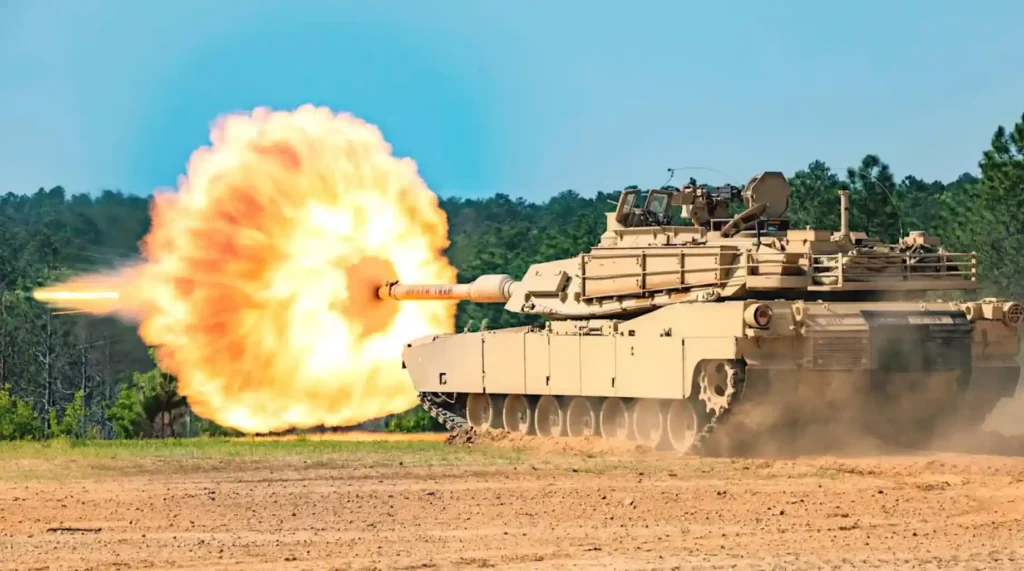
In fact, the M1 Abrams has a firing range of up to 4,000 meters, making it highly effective in open battlefield scenarios.
Combat capabilities are further enhanced by the tank’s ability to fire a variety of ammunition types, including Armor-Piercing Fin-Stabilized Discarding Sabot (APFSDS) rounds, which are specifically designed to penetrate heavy armor.
Additionally, the High-Explosive Anti-Tank (HEAT) rounds provide versatility against a wide range of targets, from armored vehicles to fortified structures.
The combination of the M1 Abrams’ powerful cannon, advanced targeting systems, and versatile ammunition makes it a dominant force on the battlefield. In recent conflicts, the tank has proven its effectiveness, earning a reputation as one of the world’s most formidable battle tanks.
The M1 Abrams Cost and Economics
M1 Abrams Cost and Price Factors
One of the most common questions about the M1 Abrams tank revolves around its cost. The price of an M1 Abrams can vary significantly depending on the model and additional upgrades or customizations.
As of recent estimates, the cost of a standard M1A2 SEP v3 can be as high as $9 million per unit. This price covers the base vehicle without additional upgrades, such as specialized armor or advanced digital systems.
Several factors influence the M1 Abrams price:
- Armor Upgrades: Enhancements to the armor, including additional layers or reactive armor systems, can increase costs.
- Weapon Systems: Upgrading the main cannon or adding more sophisticated targeting systems can impact the total cost.
- Technology Packages: Advanced communications, command-and-control systems, and digital enhancements also contribute to the overall price.
While the initial M1 Abrams tank cost may seem high, it reflects the advanced capabilities and cutting-edge technologies integrated into the tank.
Maintenance and Operational Costs
Owning and operating an M1 Abrams is not just about the initial purchase price; ongoing maintenance and operational costs are substantial. Due to its sophisticated systems and gas turbine engine, regular upkeep and specialized parts are required to keep the tanks in peak condition.
Some factors that affect maintenance costs include:
- Engine Overhauls: The AGT1500 engine requires regular inspections and maintenance to ensure optimal performance. This can be a costly and time-consuming process.
- Fuel Costs: As mentioned earlier, the M1 Abrams fuel consumption is high, which adds to the ongoing operational expenses. Considering its fuel capacity of 500 gallons, logistical planning is essential.
- Part Replacements: Over time, the tracks, suspension, and armament require regular servicing and part replacements.
To manage these costs, the U.S. military has developed comprehensive maintenance schedules and training programs for its personnel. These initiatives help reduce downtime and maximize the lifespan of the tanks.
The Future of the M1 Abrams Tank and Its Replacements
How Many M1 Abrams Does the US Have?
As of recent reports, the United States military operates thousands of M1 Abrams tanks across different versions and units. Current estimates suggest that the U.S. Army and Marine Corps collectively possess over 6,000 Abrams tanks, though not all are in active service.
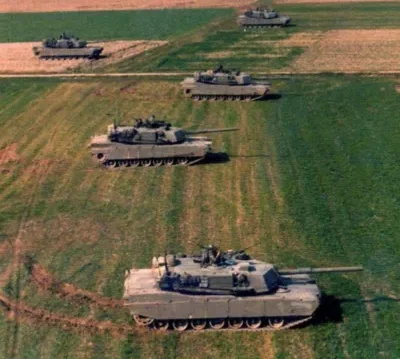
A significant portion of these tanks, particularly older models like the M1A1, are kept in reserve or used for training purposes.
The new M1 Abrams tank variants, such as the M1A2 SEP v3, are currently being produced to replace or upgrade older models. These newer versions incorporate the latest technological advancements and are expected to remain in service for years to come.
M1 Abrams Tank Replacement Programs
While the M1 Abrams tank remains highly effective, the U.S. military is continuously looking towards the future of armored warfare. There have been ongoing discussions about potential replacements or major upgrades for the M1 Abrams to ensure it remains relevant on future battlefields.
Several replacement programs and modernization efforts are in development, focusing on technologies such as:
- Artificial Intelligence (AI) Integration: Future tanks may incorporate AI-driven systems for enhanced targeting, navigation, and situational awareness.
- Autonomous Systems: The possibility of semi-autonomous or fully autonomous armored vehicles is being explored, which would reduce the need for a human crew in high-risk combat zones.
- Lighter, More Efficient Designs: Future tanks may be designed to reduce weight and improve fuel efficiency without sacrificing armor or firepower.
These projects are still in the conceptual and experimental stages, but they indicate the direction that the U.S. military is heading when it comes to next-generation armored vehicles.
Potential Future Technologies
Several advanced technologies could shape the next generation of main battle tanks:
- Electromagnetic Armor: A new type of active armor that uses electrical currents to disrupt incoming projectiles.
- Directed Energy Weapons: Weapons such as lasers that could be used to disable enemy electronics or incoming munitions.
- Hybrid Engines: Tanks powered by a combination of electric and traditional fuel-based engines could offer enhanced range and reduced fuel consumption.
While no definitive timeline has been set for the M1 Abrams replacement, the military is clearly preparing for a future where technology and innovation drive the next era of armored warfare.
Frequently Asked Questions About the M1 Abrams Tank
Who Makes the M1 Abrams?
The M1 Abrams tank is manufactured by General Dynamics Land Systems (GDLS), a division of General Dynamics. General Dynamics has been responsible for producing and upgrading the M1 Abrams series since its inception in the late 1970s.
Over the years, GDLS has played a crucial role in integrating cutting-edge technologies and enhancements into the tank, making it one of the most advanced main battle tanks in the world.
For more information about General Dynamics and its role in producing the M1 Abrams, you can visit General Dynamics Land Systems.
How Fast Is the M1 Abrams?
The M1 Abrams top speed is impressive for a tank of its size. It can reach up to 45 mph (72 km/h) on paved roads and around 30 mph (48 km/h) on rough terrain.
This speed is made possible by the powerful AGT1500 gas turbine engine, which provides the necessary m1 abrams horsepower to propel the tank swiftly across a variety of environments.
What Is the M1 Abrams Weight?
The weight of the M1 Abrams tank varies depending on the model and upgrades. On average, the tank weighs around 60 tons for the earlier versions, such as the M1 and M1A1.
The weight has increased over time with advancements in armor and technology, with the newer M1A2 SEP variants weighing in at approximately 73.6 tons.
What Are the Key Features of the M1 Abrams Tank Armor?
The M1 Abrams tank armor is designed with multi-layered composite materials, which include ceramics, metals, and Kevlar. This special blend of materials, known as Chobham armor, provides exceptional protection against various threats, including kinetic energy projectiles and explosive munitions.
Additionally, the tank is equipped with a spall liner inside to protect the crew from internal shrapnel caused by incoming rounds.
Here’s a quick breakdown of the M1 Abrams tank armor features:
- Composite Chobham Armor: Multi-layered design for enhanced protection.
- Reactive Armor (optional): Additional layers that react to impacts by neutralizing incoming explosives.
- Spall Liner: Internal protection to shield crew members from shrapnel.
For a deeper dive into the details of modern tank armor, check out this resource on composite armor.
Conclusion: The Legacy and Future of the M1 Abrams Tank
The M1 Abrams tank has proven its worth over decades of service, establishing itself as a key asset in the U.S. military’s arsenal. With its blend of advanced armor, powerful engine, and formidable firepower, it continues to set the standard for modern main battle tanks. As technology advances, the M1 Abrams will likely evolve even further, ensuring its relevance on future battlefields.
In this guide, we’ve explored the history, specifications, costs, and future of the M1 Abrams, covering every aspect you need to know. Whether you’re interested in its armor capabilities, top speed, or the interior layout, the M1 Abrams remains a fascinating subject of study and admiration.
If you have any other questions or would like to see more content like this, feel free to drop a comment or check out other resources linked throughout this post.
Share
Defense Feeds
Defense Feeds is publication focusing on informing, engaging, and empowering the world by providing accurate information from defense technology.
Powered by Defense Feeds © 2025 – All rights reserved.


